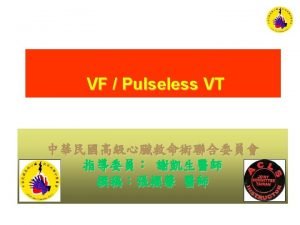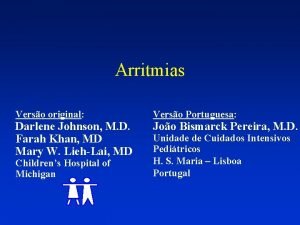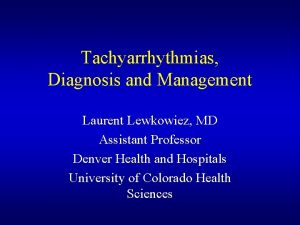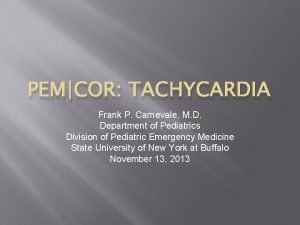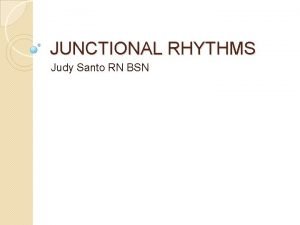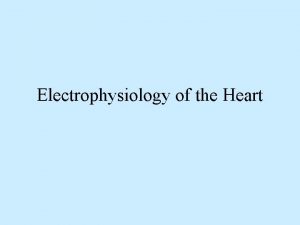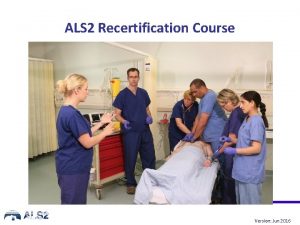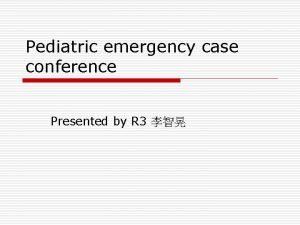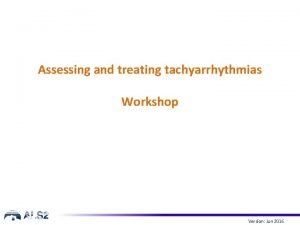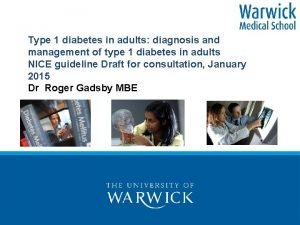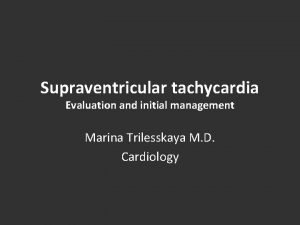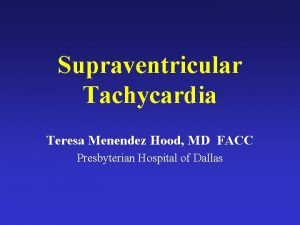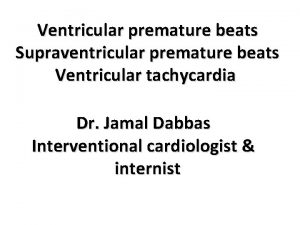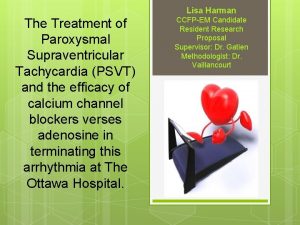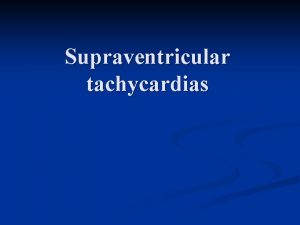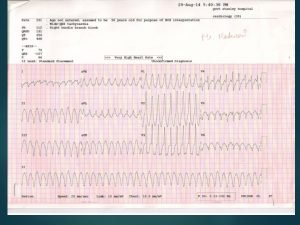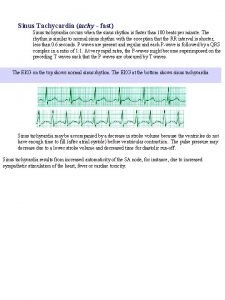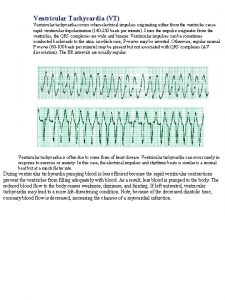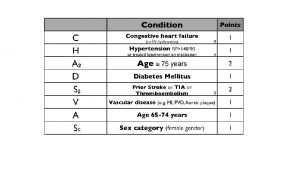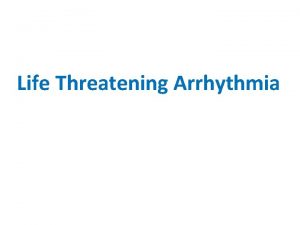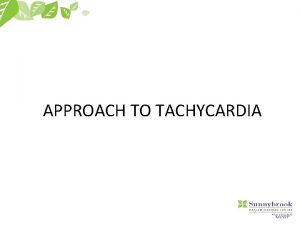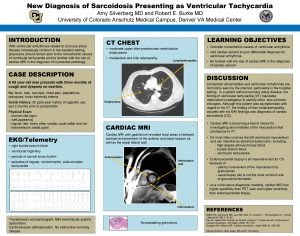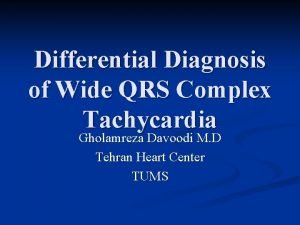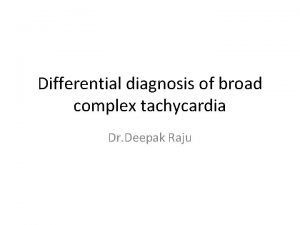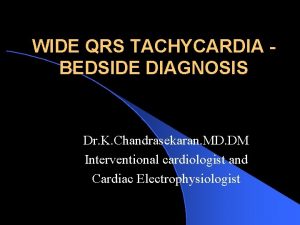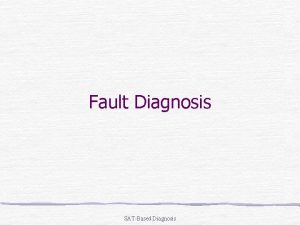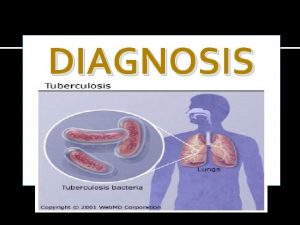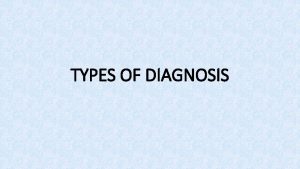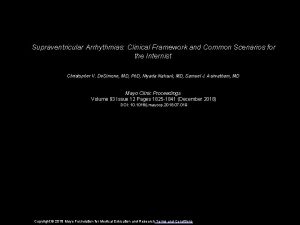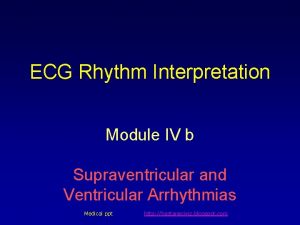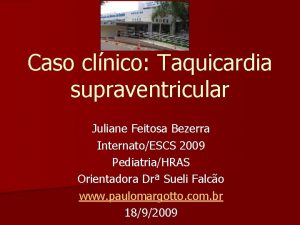The diagnosis and management of supraventricular tachycardia in














































- Slides: 46

The diagnosis and management of supraventricular tachycardia in infants Part I: Establishing a diagnosis Leonard Steinberg, MD Timothy Knilans, MD The Heart Center Children’s Hospital Medical Center Cincinnati, OH

Overview General information Categorizing tachycardia Diagnosis Therapy (part II)

General information Occurs in 1 in 250 to 1000 children 50% of cases occur in infants most present in first 3 months Low recurrence rate in infants AP mediated tachycardia recurrences uncommon by 1 year § some infants have no recurrences § at least 30% of infants with an accessory pathway are non-inducible at 1 year § no known predictive factors for recurrence automatic atrial tachycardias less likely to resolve Low death rate particularly if structurally normal heart

Possible presentations Incidental finding Lethargy Congestive heart failure § § § hydrops diaphoresis tachypnea poor feeding growth failure Shock Structural heart disease

Heart disease associated with SVT Accessory pathways § Ebstein’s anomaly § tricuspid atresia § mitral atresia (hypoplastic left heart syndrome) § corrected transposition of the great arteries (L-TGA) Automatic atrial tachycardias § cardiomyopathy / myocarditis ANY incessant tachycardia can CAUSE cardiomyopathy Atrial fibrillation § always associated with congenital heart disease Associated with VERY poor prognosis

Other diseases associated with SVT Chaotic (or other automatic) atrial tachycardia § RSV tachycardia unrelated to ß-agonists or hypoxia patients with structurally normal hearts do not have recurrences § cocaine (in utero)

Categorizing tachycardia Location Mechanism Location Frequency Re-entrant Atrial flutter Atrial fibrillation AV Node and AV node re-entry His Bundle Atrium and WPW Ventricle Concealed AP PJRT Mahaim Mechanism Automatic atrial tachycardia Chaotic atrial tachycardia Junctional tachycardia

Re-entrant Classifying tachycardia: mechanism (1) reentrant atrial tachycardia (atrial flutter) (2) AV reentry a. WPW orthodromic antidromic “two pathway” b. concealed accessory pathway c. PJRT d. Mahaim (3) AV node reentry a. typical b. atypical (4) atrial fibrillation Automatic (1) automatic atrial tachycardia (2) automatic junctional tachycardia (3) chaotic (multifocal) atrial tachycardia

Categorizing tachycardia: mechanism Re-entrant (1) reentrant atrial tachycardia (atrial flutter)

Re-entrant (1) reentrant atrial tachycardia (atrial flutter) (2) AV reentry a. WPW Categorizing tachycardia: mechanism

Re-entrant (1) reentrant atrial tachycardia (atrial flutter) (2) AV reentry a. WPW orthodromic Categorizing tachycardia: mechanism

Re-entrant (1) reentrant atrial tachycardia (atrial flutter) (2) AV reentry a. WPW orthodromic antidromic Categorizing tachycardia: mechanism

Re-entrant Categorizing tachycardia: mechanism (1) reentrant atrial tachycardia (atrial flutter) (2) AV reentry a. WPW orthodromic antidromic “two pathway”

Re-entrant Categorizing tachycardia: mechanism (1) reentrant atrial tachycardia (atrial flutter) (2) AV reentry a. WPW orthodromic antidromic “two pathway” b. concealed accessory pathway x

Re-entrant Categorizing tachycardia: mechanism (1) reentrant atrial tachycardia (atrial flutter) (2) AV reentry a. WPW orthodromic antidromic “two pathway” b. concealed accessory pathway c. PJRT

Re-entrant Categorizing tachycardia: mechanism (1) reentrant atrial tachycardia (atrial flutter) (2) AV reentry a. WPW orthodromic antidromic “two pathway” b. concealed accessory pathway c. PJRT d. Mahaim

Re-entrant Categorizing tachycardia: mechanism (1) reentrant atrial tachycardia (atrial flutter) (2) AV reentry a. WPW orthodromic antidromic “two pathway” b. concealed accessory pathway c. PJRT d. Mahaim (3) AV node reentry a. typical Slow Fast

Re-entrant Categorizing tachycardia: mechanism (1) reentrant atrial tachycardia (atrial flutter) (2) AV reentry a. WPW orthodromic antidromic “two pathway” b. concealed accessory pathway c. PJRT d. Mahaim (3) AV node reentry a. typical b. atypical Slow Fast

Re-entrant Categorizing tachycardia: mechanism (1) reentrant atrial tachycardia (atrial flutter) (2) AV reentry a. WPW orthodromic antidromic “two pathway” b. concealed accessory pathway c. PJRT d. Mahaim (3) AV node reentry a. typical b. atypical (4) atrial fibrillation

Re-entrant Categorizing tachycardia: mechanism (1) reentrant atrial tachycardia (atrial flutter) (2) AV reentry a. WPW orthodromic antidromic “two pathway” b. concealed accessory pathway c. PJRT d. Mahaim (3) AV node reentry a. typical b. atypical (4) atrial fibrillation Automatic (1) automatic atrial tachycardia

Re-entrant Categorizing tachycardia: mechanism (1) reentrant atrial tachycardia (atrial flutter) (2) AV reentry a. WPW orthodromic antidromic “two pathway” b. concealed accessory pathway c. PJRT d. Mahaim (3) AV node reentry a. typical b. atypical (4) atrial fibrillation Automatic (1) automatic atrial tachycardia (2) automatic junctional tachycardia

Re-entrant Categorizing tachycardia: mechanism (1) reentrant atrial tachycardia (atrial flutter) (2) AV reentry a. WPW orthodromic antidromic “two pathway” b. concealed accessory pathway c. PJRT d. Mahaim (3) AV node reentry a. typical b. atypical (4) atrial fibrillation Automatic (1) automatic atrial tachycardia (2) automatic junctional tachycardia (3) chaotic (multifocal) atrial tachycardia

Atrium Classifying tachycardia: location automatic atrial tachycardia reentrant atrial tachycardia chaotic atrial tachycardia atrial fibrillation AVN and His bundle AV node reentry tachycardia automatic junctional tachycardia Atrium and ventricle accessory pathway tachycardia concealed WPW PJRT Mahaim

Classifying tachycardia: frequency

Frequency accessory pathway SVT

Frequency atrial tachycardias

Frequency rare tachycardias AV node re-entry: frequency uncertain

Frequency rare tachycardias Atrial fibrillation Chaotic atrial Automatic junctional tachycardia Mahaim

Differential diagnosis ECG analysis Rate Atrial activity AV relationship Rhythm perturbations QRS morphology

ECG analysis: rate 600 Atrial Rate Atrial reentry 500 300 AVRT 250 AVNRT 200 150 PJRT Automatic tachycardias

ECG analysis: rate 600 Constant rate Variable rate Atrial reentry Atrial Rate 500 300 250 200 150 AVRT AVNRT PJRT Automatic tachycardias PJRT

ECG analysis: atrial activity Where on the ECG § § shorter diastolic interval compare QRS high frequency activity in T waves look for 2: 1 conduction Where in the atrium (p wave axis) § inferior: must be primary atrial tachycardia § superior axis indicates pathology § check V 1 & V 2 when tachycardia looks like sinus rhythm § variable: chaotic atrial tachycardia

ECG analysis: AV relationship More A’s than V’s AV reentry • AV node reentry • Junctional tachycardia • Primary atrial tachycardia • More V’s than A’s Excluded • AV reentry • Primary atrial tachycardia • AV node reentry Unlikely Probably • Junctional tachycardia. Wide complex is ventricular until proven otherwise

ECG analysis: the RP interval Useful in distinguishing AV reentry from AV node reentry tachycardias £ 70 msec traditionally associated with AVNRT > 70 msec accessory pathway > PR interval PJRT or atypical AVNRT

ECG analysis rhythm perturbations Tachycardia onset Bundle branch block Termination Vagal maneuvers Adenosine response

ECG analysis rhythm perturbations Tachycardia onset Bundle branch block Termination Vagal maneuvers Adenosine response Sinus P PAC

ECG analysis rhythm perturbations Tachycardia onset Bundle branch block Termination Vagal maneuvers Adenosine response a. VF V 1 Right Atrium

ECG analysis rhythm perturbations Tachycardia onset Bundle branch block Termination Vagal maneuvers Adenosine response P wave No P wave

ECG analysis rhythm perturbations Tachycardia onset Bundle branch block Termination Vagal maneuvers Adenosine response P wave No P wave

ECG analysis rhythm perturbations Tachycardia onset Bundle branch block Termination Vagal maneuvers Adenosine response

ECG analysis rhythm perturbations Considerations when terminating SVT § obtain rhythm recording § save vagal maneuvers for known diagnosis § adenosine response accessory pathway § watch for adenosine side effects

ECG analysis QRS morphology Narrow complex (normally conducted QRS) § cannot be antidromic tachycardia Wide complex § any narrow complex tachycardia with aberrant conduction (more frequently LBBB in infants) § any narrow QRS tachycardia mechanism with an antegrade bystander AP § antidromic AV reentrant tachycardia (including Mahaim tachycardia-rare) * VENTRICULAR TACHYCARDIA * ventricular complexes and aberrantly conducted supraventricular complexes may have “narrow QRS” appearance

Diagnosis noninvasive modalities Holter and event monitors § occasionally helpful in establishing diagnosis § evaluate therapeutic effect Echocardiography § § incessant tachycardia diminished function structural heart disease prior to EP study § in utero tachycardia

Diagnosis minimally invasive modalities Atrial electrogram § esophageal lead or atrial pacing wires § identify atrial activity § evaluate antegrade conduction over an accessory pathway § effectiveness of therapy § pace terminate re-entrant arrhythmias

The EP study Rarely required Usually performed in association with need for definitive therapy Indications § refractoriness to multiple medical regimens § hemodynamic compromise or poor function § concurrent need for hemodynamic catheterization § impending loss of catheter access ASD closure Palliation for complex congenital heart disease

Summary Accurate diagnosis as a prelude to therapy Classify ECG Other diagnostic modalities Structural heart disease
 Acls stroke
Acls stroke Resposta ventricular rápida
Resposta ventricular rápida The nursing process
The nursing process Medical diagnosis and nursing diagnosis difference
Medical diagnosis and nursing diagnosis difference Second phase of nursing process
Second phase of nursing process Medical diagnosis and nursing diagnosis difference
Medical diagnosis and nursing diagnosis difference Orthodromic reciprocating tachycardia
Orthodromic reciprocating tachycardia Vagal maneuvers
Vagal maneuvers What causes junctional rhythm
What causes junctional rhythm Normal r wave height
Normal r wave height Inappropriate sinus tachycardia ecg
Inappropriate sinus tachycardia ecg Acls bradycardia algorithm
Acls bradycardia algorithm Als2 tachycardia algorithm
Als2 tachycardia algorithm Dc cardioversion pals
Dc cardioversion pals Junctional rhythm
Junctional rhythm Als2 tachycardia algorithm
Als2 tachycardia algorithm Perbedaan diagnosis gizi dan diagnosis medis
Perbedaan diagnosis gizi dan diagnosis medis Type 1 diabetes in adults diagnosis and management
Type 1 diabetes in adults diagnosis and management Hình ảnh bộ gõ cơ thể búng tay
Hình ảnh bộ gõ cơ thể búng tay Slidetodoc
Slidetodoc Bổ thể
Bổ thể Tỉ lệ cơ thể trẻ em
Tỉ lệ cơ thể trẻ em Gấu đi như thế nào
Gấu đi như thế nào Tư thế worm breton là gì
Tư thế worm breton là gì Chúa yêu trần thế alleluia
Chúa yêu trần thế alleluia Môn thể thao bắt đầu bằng chữ đua
Môn thể thao bắt đầu bằng chữ đua Thế nào là hệ số cao nhất
Thế nào là hệ số cao nhất Các châu lục và đại dương trên thế giới
Các châu lục và đại dương trên thế giới Công thức tiính động năng
Công thức tiính động năng Trời xanh đây là của chúng ta thể thơ
Trời xanh đây là của chúng ta thể thơ Mật thư anh em như thể tay chân
Mật thư anh em như thể tay chân Làm thế nào để 102-1=99
Làm thế nào để 102-1=99 Phản ứng thế ankan
Phản ứng thế ankan Các châu lục và đại dương trên thế giới
Các châu lục và đại dương trên thế giới Thơ thất ngôn tứ tuyệt đường luật
Thơ thất ngôn tứ tuyệt đường luật Quá trình desamine hóa có thể tạo ra
Quá trình desamine hóa có thể tạo ra Một số thể thơ truyền thống
Một số thể thơ truyền thống Cái miệng nó xinh thế chỉ nói điều hay thôi
Cái miệng nó xinh thế chỉ nói điều hay thôi Vẽ hình chiếu vuông góc của vật thể sau
Vẽ hình chiếu vuông góc của vật thể sau Thế nào là sự mỏi cơ
Thế nào là sự mỏi cơ đặc điểm cơ thể của người tối cổ
đặc điểm cơ thể của người tối cổ V cc cc
V cc cc Vẽ hình chiếu đứng bằng cạnh của vật thể
Vẽ hình chiếu đứng bằng cạnh của vật thể Tia chieu sa te
Tia chieu sa te Thẻ vin
Thẻ vin đại từ thay thế
đại từ thay thế điện thế nghỉ
điện thế nghỉ
